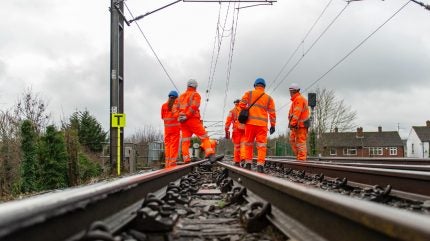
Network Rail, the UK’s rail infrastructure manager, has put climate change at the centre of its operations as it enters its next five-year funding period, Control Period 7 (CP7).
Improving the weather resilience of the UK’s rail network, investing in early warning technology, and renewing ageing infrastructure are some of the targets set in the public body’s outline for CP7 as part of its £45.5bn ($57.4bn) rail improvement plan.
Chief Executive Andrew Haines said: “Tackling climate change, safely improving train performance, adapting and responding to changing commuter habits whilst managing an ageing infrastructure requires the whole industry to rally for the benefits of all rail users.
“Whilst there are challenges and opportunities ahead, our mission is constant – we’re here to connect people and goods with where they need to be.”
Haines, who also described climate change as the “biggest challenge” faced by Network Rail, admitted it would be impossible to completely “weatherproof” the network but said the UK could be better prepared to mitigate extreme weather.
Technology to be installed to help address this issue includes GUSTO, which uses topography to predict windspeeds and enable trains to run at higher speeds even during stormy weather.

US Tariffs are shifting - will you react or anticipate?
Don’t let policy changes catch you off guard. Stay proactive with real-time data and expert analysis.
By GlobalDataNetwork Rail said it would build or rebuild more than 600km of drains to enable the railway to cope with heavier rainfall and reduce flooding, as well as recruiting almost 400 more drainage engineers to improve the care and maintenance of the network’s drainage systems.
The plan for CP7 was approved by the UK regulatory body, the Office of Rail and Road, last year after it told Network Rail to improve its focus on train performance and increase spending on the maintenance of core assets.
As a result, Network Rail said it had increased its projected spending on maintenance activity by 6%, to £12.6bn, compared to CP6, with £19.3bn also being spent on renewals across its five regional organisations.
While the CP7 plan has largely been welcomed by the rail industry, the Railway Industry Association (RIA) called on the UK Government to publish an “enhancement plan” to confirm which of its proposed network improvements will be brought forward in CP7.
RIA Chief Executive Darren Caplan said: “We again urge the government to publish a plan which sets out which rail schemes in Network North, the Integrated Rail Plan for the North & Midlands, and the Rail Network Enhancements Pipeline it intends to bring forward over the next five years.
“Doing so will enable NR and rail suppliers to ensure they are ready to carry out and co-ordinate both renewals and enhancements work in CP7.”
Fit for the future
Funding for the plan will come from the UK and Scottish Governments (£29.8bn, $37.6bn), track access charges raised from rail operators (£13.8bn, $17.4bn), and Network Rail’s commercial income from property, retail and freight (£1.7bn, $2.1bn).
UK Rail Minister Huw Merriman said: “The network must be fit for the future, with the resilience to handle extreme weather while offering the reliability and level of service our passengers deserve.
“I am confident the plan set out by Network Rail today will help keep our railways on track for the coming years.”
However, CP7 could see the body begin the transition to Great British Railways, a new integrated body for the UK rail network proposed by the government.



